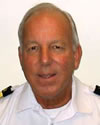by Captain Murray Lister, former Master, New Zealand Pacific

Eighteen years ago Rich and I initially met when, on 22 November 1990, the first Great American capsized 400 miles West of Cape Horn in horrendous weather conditions. Of my eight passages around Cape Horn, all in a more than 60,000 ton container ship, the storm from which we rescued Rich and his mate, Steve Petengill, was by far the worst storm I have encountered in the Southern Ocean. Consider now, Rich making that same passage, yet again, in a 8.5 ton boat.
I still maintain that the finding of Great American (predecessor to Great American II and Great American III) in the middle of the night, with 35-foot-high swells, 65-knot wind and blowing snow, to be one of the greatest pieces of good fortune in which I have been involved. This, followed by the magnificent seamanship displayed by Captain David Watt when he manoeuvred our ship, New Zealand Pacific, right alongside Great American, completed the rescue. Rescues at sea are not uncommon. What made Great American‘s rescue more momentous than most were the weather conditions in which it was carried out.
Rich and I, both sailing nuts, have kept in touch over the past 18 years, to the extent that in June 2008 my wife and I were honoured to meet Rich again along with 20 other members of the Eastern Yacht Club in Marblehead, Massachusetts, USA. We were treated like royalty, and the visit culminated in dinner and a presentation of the Burgee Of Merit Award for the ship New Zealand Pacific.
Every Captain of a ship has a legal, as well as moral, responsibility, to attempt to rescue any seafarer in distress. This is laid out as part of the SOLAS Regulations, (Saving Of Life At Sea). Even in races such as the Vendée Globe, if a competitor requires assistance, another competitor must stop racing and help if he or she is the nearest boat.
We certainly trust that Rich will not repeat the actions of Thanksgiving Day 1990.
